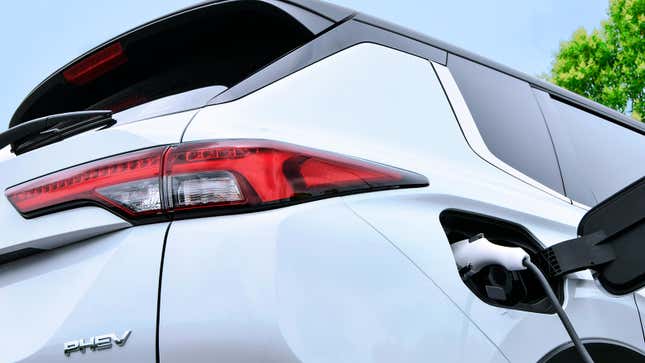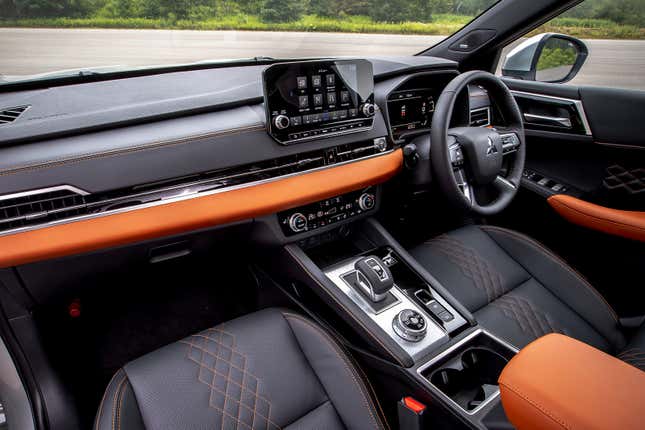The 2023 Mitsubishi Outlander plug-in hybrid starts at $41,190, including destination. That’s quite high for a Mitsubishi but not the average new car — Kelley Blue Book pinned the U.S.’s average transaction price at $48,301 back in August. Mitsubishi revealed across-the-board pricing for every trim level of the Outlander PHEV this week, and for the nicest, best-equipped example, you’ll pay barely more than that: $51,340.
The SEL trim level, which appears to be the sweet spot at the middle of the range, costs $46,790. There, you get a lot of luxuries: leather-upholstered seats, an 8-way adjustable front-passenger seat with memory, heated rear seats and triple-zone climate control, among other niceties.
The SEL Touring, for about two grand more, grants a heads-up display, heated steering wheel, panoramic sunroof, and a Bose premium audio system. At the top of the range — the SEL Premium — the company throws in semi-aniline leather and massaging front seats. The price? Just $49,490.

Beyond that, there’s the 40th Anniversary Edition, meant to commemorate Mitsubishi’s four decades in North America. It adds “Black Diamond” paint with a bronze roof (!) and nice badges. But for the most part, Mitsubishi will sell you its best for merely $1,000 more than the average new car. That sounds like a pretty solid deal to me. I’ll admit, I almost wrote this story expecting to giggle at the suggestion of a $50,000 Mitsubishi, but we’re in frustrating times, to put it mildly, and taking the whole scope of the market, this actually isn’t terrible. $50,000 today would’ve been worth $38,677 10 years ago, after all.
As far as internals and performance are concerned, the Outlander appears to be a decently efficient SUV for its size, and it’s got the brand’s signature S-AWC all-wheel-drive system for good measure. But don’t get any wild visions about the second coming of the Lancer Evolution, or anything of that sort. I’ll throw it back to Lawrence Hodge:
Mitsubishi says the Outlander PHEV is the “pinnacle of Mitsubishi engineering.” They may be right. A 2.4-liter Atkinson cycle I4 gets paired with a 350-volt, 20 kWh battery pack. Mitsubishi says this gives the Outlander PHEV an all-electric driving range of 38 miles. When combined with the 14.8-gallon fuel tank, it can get 64 MPGe and a combined 420 miles of driving range. Pretty impressive.
That whole setup gets paired with the company S-AWC (Super All Wheel Control). Mitsubishi says that this is a new generation of the company’s all wheel drive setup. It utilizes the ICE engine and a front electric motor to drive the front wheels while a rear-mounted electric motor drives the rear wheels. Total combined system horsepower is 248 and 332 lb-ft of torque.
Let’s give credit where it’s due, too: the interior actually looks fantastic. I’m sure some of that feeling can be attributed to the bar for “fantastic” being regrettably low for Mitsubishi in this day and age, but still — I’d take the Outlander’s exterior and interior over the RAV4 Prime’s every day of the week.

Unfortunately, when you compare the Outlander PHEV to the RAV4 Prime in just about every other metric, yeah — Toyota wins out, handily. More horsepower (albeit less torque), a whopping 94 MPGe versus the Outlander’s 64 MPGe, and the ability to travel up to another 120 miles on a full tank of gas and a fully charged battery, for a total range of 600 miles. The Outlander technically has a third row of seats the RAV4 Prime doesn’t, but it’s really usable only if your least-liked passengers don’t have legs.
Still, I like where Mitsubishi is going, I really do. This is probably the only compelling product the company has given us in some 15 years that doesn’t have “Evolution” in the name. You’re almost there, team — just a little bit more.